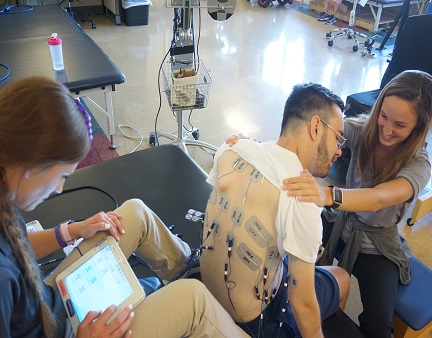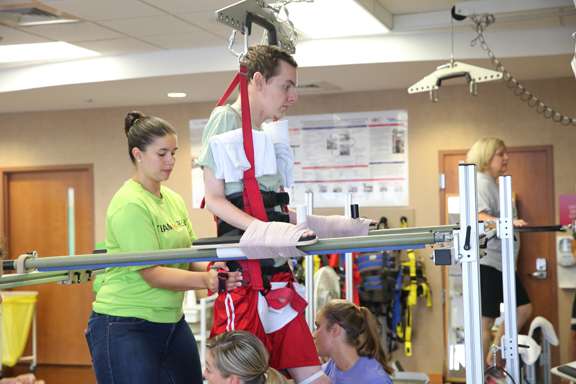C.O.R.E.
Comprehensive
The Metabolic, Neuromuscular, and Skeletal core takes a comprehensive look at in-vivo skeletal muscle contractile properties, architecture, volume and oxidative capacity; bone density; dietary intake, total body fat mass and fat-free mass. These assessments can give researchers a good look at what is going on inside the body and how efficiently it is functioning.
Objective
Metabolic Assessments
- Bod Pod: Body composition is assessed by analyzing air displacement characteristics while the individual sits quietly inside the BodPod chamber for about 5 minutes.
- Bioelectrical Impedance Spectroscopy (BIS): Small sensors placed at the wrists, hands, ankles, and feet allow for measurements of fat mass, fat free mass, intracellular fluids and extracellular fluids when a small undetectable current is passed through the body.
- Bioelectrical Impedance Analysis (BIA): an unnoticeable amount of low-level electrical current is sent though the body allowing for measurements of fat-free mass, body fat content and total body water.
- Skinfolds: the thickness of the skin is measured at ten different sites using a skinfold caliper, circumference of arms, legs, neck, and trunk are also measured using a flexible measuring tape; these measurements allow for a calculation of body fat percentage and body density.
- Dietary Log: a dietary log of a period of 5 consecutive days is completed by the participant so that their dietary energy intake can be estimated.
- Neurogenic Bowel Dysfunction Score: a questionnaire developed to assess an individual’s neurogenic bowel as it impacts their quality of life.
- Cardio-Metabolic Rick Assessment: a small blood sample drawn after 10-14 hour fasting period and again various times after drinking a sugar solution, blood samples allow for calculation of blood glucose level and a lipid profile; a urine sample will also be collected to provide key information such as liver function and inflammatory status.
- Gut MicroBiome Assessment: Participants are given materials and instructions and asked to collect a stool sample within 24 hours of their clinical visit, data from the analysis of these samples is used to study the relationship between neurogenic bowel associated to a spinal cord injury and intestinal microbial composition.
Neuromuscular Assessments
- Lower Limb Magnetic Resonance Imaging (MRI): Images of the lower limbs or abdomen are taken using magnetic resonance imaging with the purpose of determining the composition and total area of the skeletal muscle.
- Musculoskeletal ultrasound: An ultrasound machine is used to scan different muscles and determine their muscle architecture, and in particular muscle thickness, fascicle length and pennation angle, which contribute to determining the muscle mechanical properties.
- Muscle Oxidative Capacity: Muscle oxygenation is monitored via non-invasive near infrared spectroscopy (NIRS) probe during electrically induced muscle contractions and following intermittent cuff occlusions to evaluate muscle oxidative capacity. A NIRS probe will be placed just above an inflating cuff on the lower limb, the NIRS probe delivers almost Infrared waves to the muscle below the layer of fat so that the rate of consumption of oxygen can be measured for each muscle.
- Echocardiogram– This assessment measures heart and blood vessel structure, and muscle properties using ultrasound and light technology. Continuous heart rate and blood pressure are monitored during the test. The ultrasound will be performed while the participant is lying down on their side, and again while they are in a seated position. This test lasts about one hour.
- Lower Extremity Torque Assessment with Neuromuscular Electrical Stimulation(NMES): muscles are tested for voluntary contractions without stimulation then electrical stimulation is provided using electrode pads placed along the calf and thigh to cause muscles to contract and tighten, the outcome of the assessment is to measure force (torque) and speed of the muscles during voluntary contractions and with stimulation under non-fatiguing and fatiguing conditions using the Biodex dynamometer.
- Upper Extremity and Trunk Torque Assessment with Neuromuscular Electrical Stimulation(NMES): muscles in the arm or trunk are tested for strength, fatigue resistance and speed of both voluntary and electrically stimulated contractions using electrodes placed in areas of the upper body.
Skeletal Assessments
- Dual-energy X-ray absorptiometry (DXA): DXA scans are performed to measure bone density and composition of whole body and different body parts.
Research-driven
We employ a “Discovery-to-Recovery” approach and work closely across disciplines to expand knowledge and bring innovative treatments to practice so that individuals with spinal cord injuries can experience their own personal Victory Over Paralysis. Our work is published in leading scientific journals and copies of our most recent articles are available here.
Evidence-based
The assessments we perform are leading to greater understanding of how we can use interventions such as Locomotor Training (LT), Neuromuscular Electrical Stimulation (NMES) and spinal cord Epidural Stimulation (scES) to regain function and improve quality-of-life for individuals with spinal cord injuries.

|
Adult NeuroRecovery
Translational Cores
Metabolic, Neuromuscular, and Skeletal
Studies
Cardiovascular and Pulmonary
Movement Performance and Locomotor Recovery
Urogenital and Bowel
Neurophysiology
Engineering
Research Medical
Biostatistics, Outcomes, Database and Communications
Finance and Administrative
Movement Performance and Locomotor Recovery Clinic
Investigators
|








